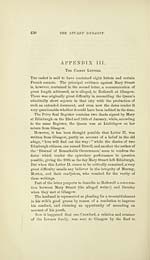Stuart dynasty
(509) Page 451
Download files
Complete book:
Individual page:
Thumbnail gallery: Grid view | List view

APPENDIX III. 451
observe details concerning the meeting of Mary and Darnley,
and in a deposition made after the murder related what the
doomed King had told him of that interview.
The late Dr. Hill Burton, no friend to Mary Stuart's cause,
was led to compare this deposition of Crawford's with the
above-named passage in Letter II., and wrote concerning them
as follows : — " Of the result I can only say that the two agree
together with an overwhelming exactness." * »
Is it not perfectly incredible that Crawford's memory of what
Darnley told him about the conversation should tally, almost
word for word and sentence for sentence, with the description
given by Mary Stuart in a letter to Both well ?
Any lawyer used to deal with evidence would necessarily
conclude — as did the late Mr. Hosack — that either Crawford
saw this alleged epistle of Mary Stuart's before he made the
deposition which included her sentences, or else this portion of
the letter was copied from the statement in question.
Our readers must decide for themselves which is most
probable, remembering, however, that Crawford had been
engaged by Lennox to collect " matter " against Mary when
accused of her husband's murder.
Available copies of what are believed to be original French
versions of the Casket Letters are these, viz. Nos. III. and V.
in the Record Office, and Nos. IV. and VI. at Hatfield.
Number VI. is a compromising document to Mary if it can
be proved genuine, because advice is therein given to Bothwell
by the writer not to entrust their guilty secret to his " false
brother" (in law), viz. Huntly. The same may be said of
Letters VII. and VIIL, although this nobleman's name is
alluded to in regard to less important matters. A great deal
has been made of the fact that Huntly never specially de-
nounced the Casket Letters as forgeries when transactions in
which he had been mixed up were freely named, but contented
himself by averring that Murray and his associates " calumniated
the Queen to cloak their own rebellion." f But is it certain that
Huntly and Argyll were allowed to see the documents in
question ? They were certainly not amongst the chosen few
* Burton's ' History of Scotland,' vol. iv. p. 267.
t Proclamation of Huntly and Argyll, Crawford's ' Scotland,' p. 90.
observe details concerning the meeting of Mary and Darnley,
and in a deposition made after the murder related what the
doomed King had told him of that interview.
The late Dr. Hill Burton, no friend to Mary Stuart's cause,
was led to compare this deposition of Crawford's with the
above-named passage in Letter II., and wrote concerning them
as follows : — " Of the result I can only say that the two agree
together with an overwhelming exactness." * »
Is it not perfectly incredible that Crawford's memory of what
Darnley told him about the conversation should tally, almost
word for word and sentence for sentence, with the description
given by Mary Stuart in a letter to Both well ?
Any lawyer used to deal with evidence would necessarily
conclude — as did the late Mr. Hosack — that either Crawford
saw this alleged epistle of Mary Stuart's before he made the
deposition which included her sentences, or else this portion of
the letter was copied from the statement in question.
Our readers must decide for themselves which is most
probable, remembering, however, that Crawford had been
engaged by Lennox to collect " matter " against Mary when
accused of her husband's murder.
Available copies of what are believed to be original French
versions of the Casket Letters are these, viz. Nos. III. and V.
in the Record Office, and Nos. IV. and VI. at Hatfield.
Number VI. is a compromising document to Mary if it can
be proved genuine, because advice is therein given to Bothwell
by the writer not to entrust their guilty secret to his " false
brother" (in law), viz. Huntly. The same may be said of
Letters VII. and VIIL, although this nobleman's name is
alluded to in regard to less important matters. A great deal
has been made of the fact that Huntly never specially de-
nounced the Casket Letters as forgeries when transactions in
which he had been mixed up were freely named, but contented
himself by averring that Murray and his associates " calumniated
the Queen to cloak their own rebellion." f But is it certain that
Huntly and Argyll were allowed to see the documents in
question ? They were certainly not amongst the chosen few
* Burton's ' History of Scotland,' vol. iv. p. 267.
t Proclamation of Huntly and Argyll, Crawford's ' Scotland,' p. 90.
Set display mode to:
![]() Universal Viewer |
Universal Viewer | ![]() Mirador |
Large image | Transcription
Mirador |
Large image | Transcription
Images and transcriptions on this page, including medium image downloads, may be used under the Creative Commons Attribution 4.0 International Licence unless otherwise stated. ![]()
| Histories of Scottish families > Stuart dynasty > (509) Page 451 |
|---|
| Permanent URL | https://digital.nls.uk/94771007 |
|---|
| Description | A selection of almost 400 printed items relating to the history of Scottish families, mostly dating from the 19th and early 20th centuries. Includes memoirs, genealogies and clan histories, with a few produced by emigrant families. The earliest family history goes back to AD 916. |
|---|

